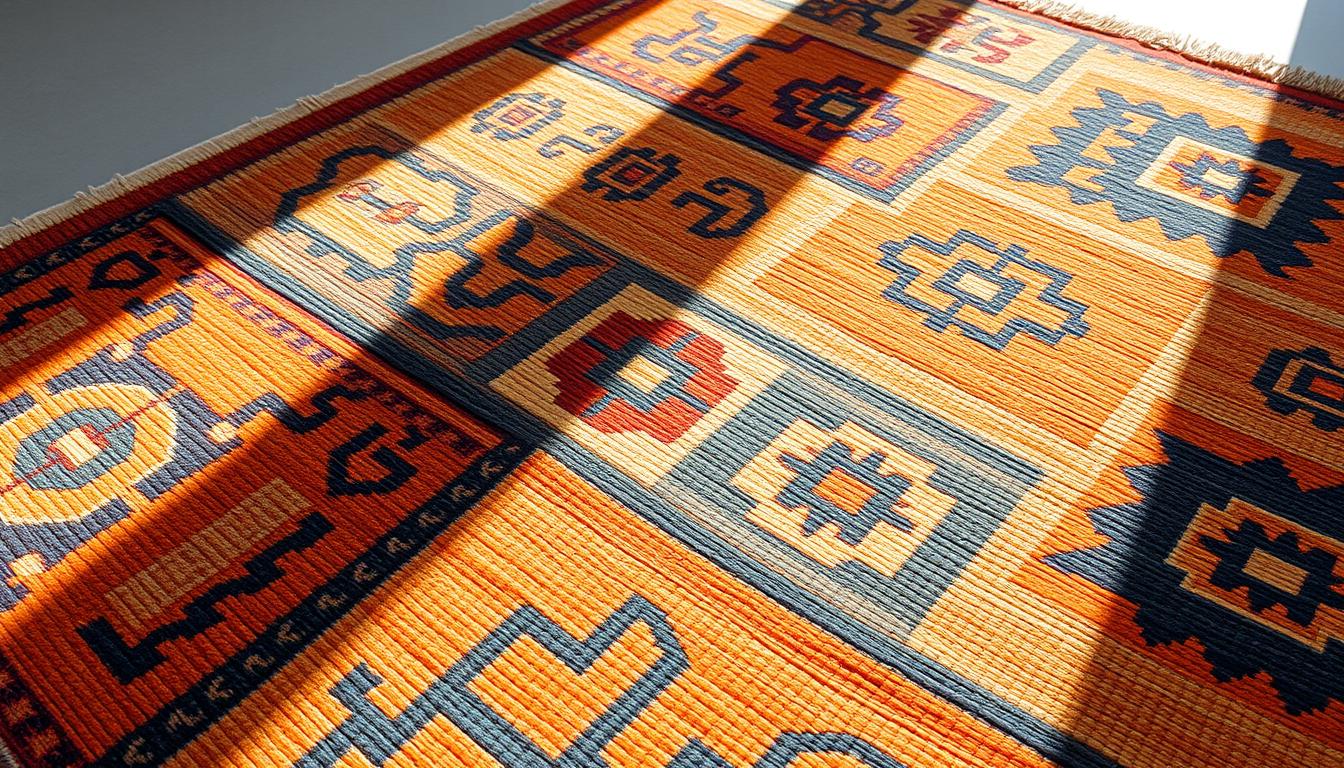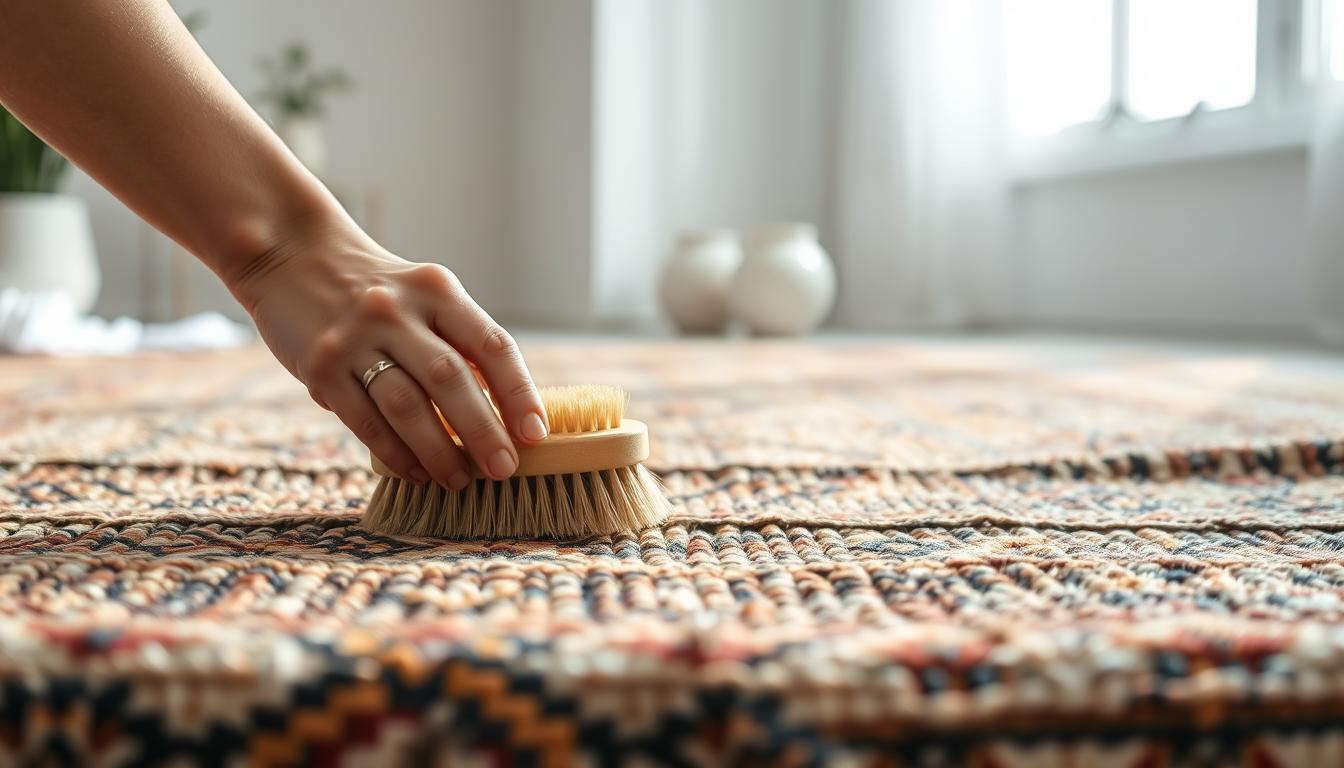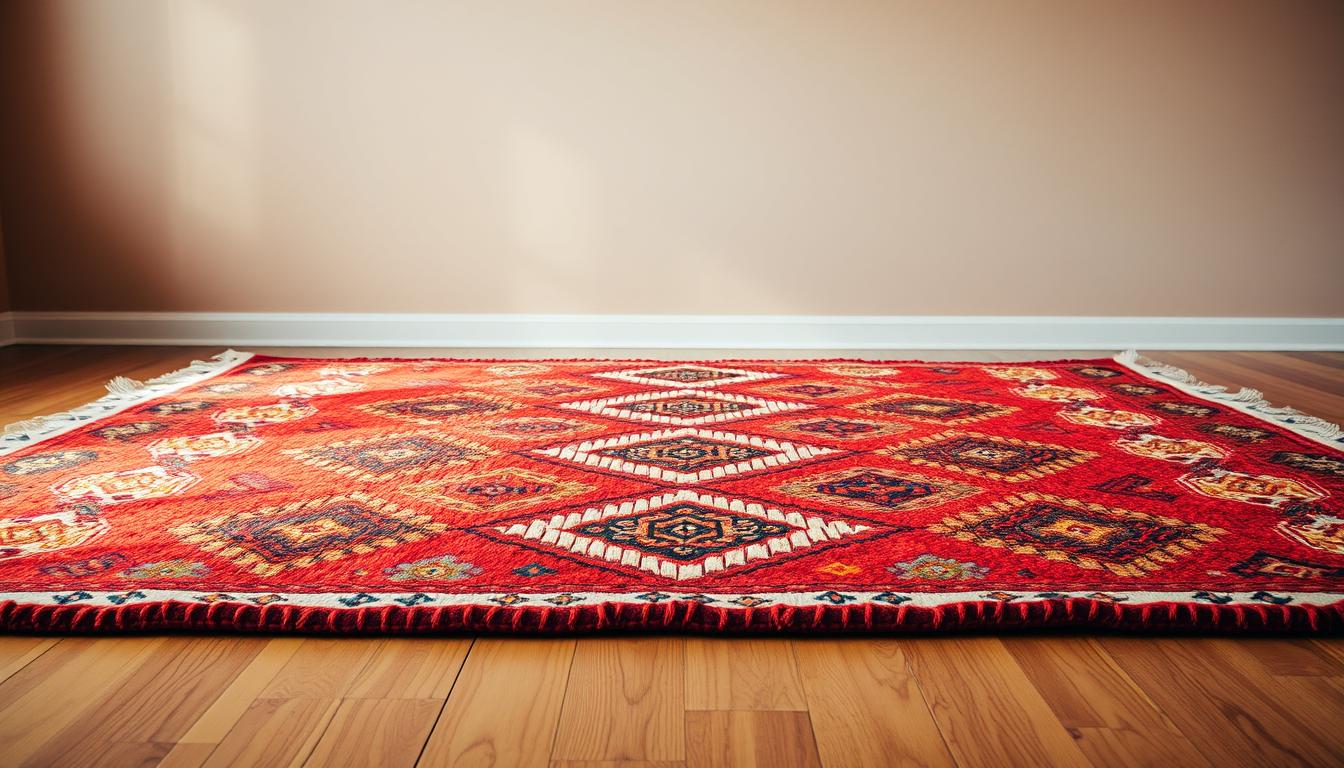
5 Creative DIY Steps for a Moroccan Rug

What if you could weave more than just wool? Imagine intertwining your personal story with the vibrant heritage of North African artisans. This guide unlocks the secrets behind crafting textiles that honor traditional Berber techniques while expressing your unique vision.
You’ll learn to select premium materials like the resilient wool from the Atlas Mountains, used for generations due to its durability and natural luster. Discover how geometric motifs carry hidden meanings – diamonds symbolizing protection, zigzags representing life’s journey.
While modern stores offer mass-produced options, nothing matches the soulful imperfections of handcrafted textiles. Through five clear steps, you’ll master foundational weaving methods perfected over millennia. This isn’t just about making floor coverings – it’s about preserving cultural narratives in every knot.
Key Takeaways
- Connect with ancestral textile traditions through hands-on creation
- Source authentic materials that ensure longevity and cultural accuracy
- Decode symbolic patterns that tell stories through geometric shapes
- Balance personal creativity with respect for traditional methods
- Develop skills that transform raw wool into functional artistry
Introduction to Your diy Moroccan Rug Project
Every thread you weave carries centuries of cultural narratives. North African artisans have transformed simple materials into storytelling canvases, blending symbolic geometry with practical craftsmanship. Your project bridges ancient traditions and modern creativity.
Understanding the Creative Process
Working with natural fibers connects you to ancestral practices. Many tribes view textile-making as meditation – rhythmic motions creating functional art. You’ll discover how simple loops and knots transform raw materials into durable pieces.
This hands-on experience teaches patience. Unlike store-bought options, handmade textiles develop character through slight variations. Each imperfection adds authenticity, mirroring life’s unpredictable beauty.
Why Embrace Symbolic Patterns?
Geometric designs hold layered meanings. Triangles might represent mountains, while diamonds symbolize protection. These visual stories originated as coded messages within communities.
Modern interiors thrive on these timeless patterns. Neutral tones and bold shapes adapt effortlessly to contemporary spaces. Your creation becomes both decor and conversation piece – a tangible link to global craftsmanship traditions.
Sourcing Authentic Materials and Tools
Your textile project’s success begins with selecting components that honor centuries-old craftsmanship. Artisans in North Africa prioritize materials that age beautifully while maintaining structural integrity. This approach transforms simple fibers into heirloom-worthy pieces.

Choosing Quality Wool and Cotton
Premium wool forms the backbone of durable textiles. Seek out fibers from sheep raised in high-altitude regions, where harsh climates produce resilient strands. These natural fibers develop richer textures over time compared to processed alternatives.
Cotton provides essential stability as a base fabric. Look for tightly woven options that withstand repeated tension during the hand-weaving process. Many traditional makers use unbleached varieties to preserve organic character.
Essential Tools for Your Project
You’ll need sharp scissors capable of cutting thick yarn bundles. Heavy-duty needles prevent breakage when working with dense materials. A sturdy loom maintains even tension – crucial for achieving professional results.
Consider sourcing tools from specialty suppliers who understand textile arts. Proper equipment elevates your work from amateur attempts to gallery-worthy creations. As one seasoned weaver notes: "The right tools don’t just assist – they amplify your vision."
Exploring Moroccan Rug Heritage and Techniques
Beneath every intricate pattern lies a language older than written words. The Beni Ourain people of the Atlas Mountains developed weaving methods that transform sheep wool into cultural documents. Their textiles serve as both floor coverings and family chronicles, encoding ancestral wisdom through tactile artistry.
The Legacy of Mountain Weavers
For centuries, Berber tribes have passed textile skills through maternal lines. Grandmothers teach daughters how to spin wool while sharing stories about fertility symbols and protective geometries. These practices create living heirlooms – each piece infused with personal journeys and communal values.
From Raw Wool to Living Color
Traditional dye masters use nature’s pantry to achieve rich hues. Pomegranate skins yield crimson tones, while saffron stamens produce golden yellows. This process connects modern creators to ancient heritage, as shown in our comparison of dye sources:
| Material | Color Produced | Cultural Significance |
|---|---|---|
| Turmeric root | Sunset yellow | Prosperity |
| Walnut shells | Deep brown | Earth connection |
| Madder root | Terracotta red | Protection |
The hand-spinning technique deserves special attention. Twisting wool fibers clockwise while singing traditional prayers creates yarn with exceptional durability. This method, detailed in our cultural techniques guide, ensures each thread carries both physical strength and spiritual intention.
Communal weaving circles demonstrate the craft’s social importance. Women gather to work looms while exchanging life stories, their rhythmic motions echoing generations of Berber tribes. This collaborative spirit transforms functional items into vessels of shared memory.
Planning and Preparing Your DIY Approach
Crafting textiles becomes an act of cultural preservation when you plan with intention. Successful projects begin long before the first knot – they start with thoughtful preparation that respects ancestral methods while making space for personal expression.

Mapping Out the Design and Pattern
Start by sketching your vision on graph paper. Traditional symbols like diamond shapes and zigzag lines carry specific meanings – study these before adapting them. As one Atlas Mountains artisan notes: "Our patterns map journeys, both physical and spiritual."
Choose colors that echo natural dyes – terracotta reds, indigo blues, and earthy neutrals create authentic harmony. Test combinations under different lighting to see how tones interact. This step prevents costly revisions later.
Measure your space carefully. Will this piece anchor a room or accent furniture? Standard sizes range from 3'x5' for entryways to 8'x10' for living areas. Mark boundaries on your loom using colored thread for visual guidance.
Build flexibility into your schedule. Handcrafting demands patience – allocate extra time for complex sections. Break the work into stages: preparation (20%), core weaving (50%), and finishing touches (30%). This structure maintains momentum without rushing artistry.
Step-by-Step Guide to Crafting Your Rug
The journey from raw fibers to finished textile reveals craftsmanship's true essence. Through rhythmic hand movements and time-tested methods, you'll transform simple materials into functional art. This phase demands patience – each action builds upon the last to create lasting beauty.
Hand Spinning, Knotting, and Weaving Techniques
Begin by twisting wool strands into robust yarn. Wrap fibers around your forearm while rotating clockwise – this traditional method creates uniform threads ideal for weaving. As one Atlas Mountains artisan explains: "The rhythm of spinning becomes a conversation between maker and material."
Secure your first row using the double knot technique. Insert small weft threads between knots to stabilize the structure. Maintain consistent tension by adjusting the loom's pegs after every completed section. This prevents uneven surfaces and ensures lasting durability.
Trimming, Dyeing, and Finishing Touches
Once removed from the loom, sculpt the pile with curved shears. Angle blades at 45 degrees for controlled trimming. For color application, immerse sections in natural dyes using the crafting wool textiles method – multiple dips create rich, layered hues.
Revive stiff fibers through repeated washing. Use cold water and gentle pounding motions to soften strands without damaging knots. Sun-dry between rinses to enhance natural luster. This final step unlocks the wool's inherent softness, transforming rigid fabric into pliable luxury.
| Stage | Key Action | Purpose |
|---|---|---|
| Spinning | Twist raw wool | Create strong yarn |
| Knotting | Secure weft threads | Ensure stability |
| Weaving | Adjust loom tension | Prevent warping |
| Dyeing | Multiple immersions | Deepen colors |
| Finishing | Cold-water washes | Enhance softness |
For detailed loom setup instructions, explore our weave from scratch guide. Remember – great textiles emerge through mindful repetition. Each step honors ancestral wisdom while shaping your creative vision.
Designing Your Unique Moroccan Rug Pattern
Your rug becomes a canvas where personal journeys meet ancient traditions. Like fingerprints in wool, patterns hold power to express identity while honoring ancestral wisdom. This creative phase lets you weave modern life into timeless designs, merging self-expression with cultural reverence.
Incorporating Cultural Symbols and Stories
Traditional motifs act as visual dictionaries. Diamonds often symbolize protection, while zigzags mirror life’s unpredictable paths. Study these stories before adapting them – a birth symbol could represent new beginnings in your narrative.
Consider this comparison of common elements:
| Symbol | Traditional Meaning | Modern Adaptation |
|---|---|---|
| Triangle | Mountain strength | Career milestones |
| Circle | Eternal life | Family unity |
| Crosshatch | Fertility | Creative growth |
As one Atlas Mountains weaver notes: "Our hands don’t just make patterns – they write history in thread." Document your design choices to preserve their significance for future generations.
Customizing Colors and Textures for Your Home
Earth tones create harmony with most decor styles. Mix ochre yellows with slate grays for contemporary spaces, or use terracotta reds to warm minimalist rooms. Test swatches under different lights to see how shades shift throughout the day.
For lasting beauty, follow proper maintenance practices that protect delicate dyes. Remember – the right color palette turns functional pieces into focal points that anchor your living space with intention and style.
Enhancing Durability and Authenticity
The true test of craftsmanship reveals itself through years of use. Proper finishing techniques transform your creation from temporary decor to heirloom-quality artistry. These methods preserve both structural integrity and cultural accuracy.
Reinforcing Seams and Edges
Start by securing borders with tight blanket stitches. This traditional method prevents fraying while maintaining the authentic look of handcrafted textiles. Artisans in North Africa often double-knot thread ends for added security.
Focus on high-traffic areas like entryways. A hidden backing fabric strengthens these zones without altering the textile's appearance. Use natural fiber patches that blend with your main material.
Inspect joins between pattern sections carefully. As one master weaver advises: "Thread tension tells stories – loose stitches whisper neglect, tight knots sing commitment." Apply beeswax to threads for smoother stitching and enhanced moisture resistance.
Consider this maintenance comparison:
| Element | Traditional Method | Modern Alternative |
|---|---|---|
| Edge Binding | Hand-rolled hem | Fabric glue |
| Seam Reinforcement | Double stitching | Fusible tape |
| Surface Protection | Lanolin treatment | Chemical sprays |
Regular care preserves value and appearance. Gentle brushing maintains pile height, while periodic rotation prevents uneven wear. These practices honor ancestral wisdom while adapting to contemporary lifestyles.
Integrating Your Rug Into Home Decor
Your handcrafted textile becomes a living element of interior storytelling. These pieces anchor spaces through cultural resonance and functional beauty. Discover how to showcase their artistry beyond conventional floor placement.
Elevating Walls and Surfaces
Turn leftover scraps into striking wall hangings. Frame geometric patterns against neutral backgrounds to highlight their symbolic depth. Smaller segments work beautifully as table runners, adding texture to dining spaces while protecting surfaces.
For Berber rugs with bold motifs, try floating mounts. This displays intricate knotwork while preserving flexibility. Rotate seasonal accents like woven coasters or trivets made from trimmed edges.
Designing Unified Spaces
Extend your textile’s color story through coordinated home accents. Dye curtain tassels to match terracotta tones in rugs. Stitch pillow covers using leftover yarn, repeating key shapes from your original pattern.
Cluster multiple pieces to create visual rhythm. Mix floor textiles with hanging art in complementary sizes. This layered approach honors traditional weaving circles where varied items shared communal spaces.
FAQ
How do Beni Ourain designs reflect Berber heritage?
These patterns originate from the Atlas Mountains, where Berber tribes use symbols to tell stories of nature, protection, and life. Geometric shapes and abstract motifs often carry generational meaning, blending artistry with cultural identity.
What materials ensure authenticity in handmade pieces?
High-quality, undyed wool from local sheep and organic cotton form the foundation. Hand-spun yarn and natural dyes like saffron or indigo replicate traditional methods, preserving the texture and softness unique to these creations.
Can I repurpose fabric scraps for smaller decor items?
Absolutely. Leftover materials can become coasters, pillow covers, or wall hangings. This approach reduces waste while adding cohesive accents to your space, maintaining the aesthetic of your main project.
How do I reinforce seams and edges for long-lasting durability?
Use a sturdy cotton thread to double-stitch seams. For edges, tightly wrap yarn around the fringe or apply a fabric-binding adhesive. This prevents fraying and maintains structural integrity over time.
What tools are essential for hand-spinning wool?
A drop spindle, carding brushes, and a loom are basics. For precision, add a tapestry needle and shears. These help maintain consistent yarn thickness and clean finishes during weaving.
How can I incorporate cultural symbols without copying traditional designs?
Study motifs like diamonds (representing femininity) or zigzags (symbolizing water). Adapt their scale, color, or arrangement to fit your vision while honoring their origins. Balance creativity with respect for the heritage.
Why choose natural dyes over synthetic alternatives?
Plant-based dyes offer subtle, earthy tones that age gracefully. They’re eco-friendly and align with traditional practices, giving your piece a muted, organic feel that synthetic colors can’t replicate.









